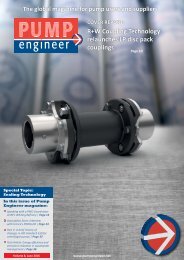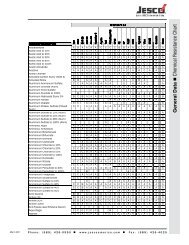KZWja
KZWja
KZWja
- No tags were found...
Create successful ePaper yourself
Turn your PDF publications into a flip-book with our unique Google optimized e-Paper software.
WIND ENERGY: APPLYING NEW TECHNOLOGY TO AN OLD IDEA95financial institutions similar to real estate projects. The majorproblem that may occur will be the lack of extensive operationalexperience, particularly on later, improved scale-ups of smallmachines, to satisfy conservative lending institutions.WIND PROJECT DEVELOPMENT-ALTAMONTPASSSiting a Wind ProjectIn 1979, PGandE and the California Energy Commissionbegan to conduct wind energy assessment studies in northernCalifornia. Using historical information, they selected variouslocations to install anemometers to measure annual windspeeds. In Altamont Pass, these studies were conducted untillate 1981 and showed that Altamont Pass had an excellent windresource with an annual mean wind speed in the range of 15 to18.6 mph.At this point, private developers began to negotiate forleases with land owners and to place their own anemometerson various pieces of land to assess the local wind resource.Given the vastness of the areas (thousands of acres), limitedinformation was refined by going out on windy days to fly kites.While it may sound strange, kite-flying provides a fairly accuratemeans of assessing the affects of topography on local windcurrents. Such methods were used to determine specificmachine locations. Since in most major California wind areas,the wind blows in predominantly one direction, most machinesare oriented in rows perpendicular to the wind. Down-windspacing to avoid long-term rotor turbulence effects is usuallybetween five to seven rotor diameters. A typical Altamont Passwind farm with substation and parallel rows of machines isshown in Figure 12.Figure 12. A 'I!Jpical \tlnd Farm Layout with Substation andRows of Machines.The Wind ResourceThe wind resource of the Altamont Pass is very reliable.Every year starting in March, the combination of warmingtemperatures in the California Central Valley (high pressure)and cool arctic currents off the coast (low pressure) of California,create conditions that draw cool heavy moist air into SanFrancisco Bay and through the low passes of the Californiacoastal mountains. One such pass is the Altamont Pass nearLivermore, California.As spring progresses to summer, coastal water upwellingand temperatures in the high 90s and low 100s in CentralCalifornia increase wind movement. The classic annual cycle ofaverage monthly wind speed averages for Altamont Pass, alongwith a probability range for annual averages near TERA Power'sDelta Energy Project Site is shown in Figure 13. Duringthe summer months, monthly average wind speeds can rangefrom 20 mph to 30 mph with some 24 hour periods equalling 40mph. Peak gusts of 60 mph are not uncommon during certainweather cycles.fQ.0tl1 20Q.(/)0zw 10(!l..:0:w',./""''Probability Range(15,1-22.1mph)1981 AVERAGEWIND SPEED (18.6 mph)1---... ·y''---------"""'.-------1 /·71984¢;Y'SED (15.4 mph)::>\\ESiimatedwindspwdonsiiEIF M A M 0 N 0Figure 13. Typical Altamont Pass Annual Wind Cycle Shownwith 1981 and 1984 Wind Data from TERA Power CorporationsDelta Energy Project.On a daily basis, winds in the Altamont Pass typicallybegin in the middle to late afternoon, peak from midnight to sixa.m. and taper off by noon. While occurring on an averagebasis, this type of cycle does not happen every day. This pointsout one of wind power's major disadvantages, that it is a nonfirmresource for utility planning and as such cannot bedispatched.Wind Resource EngineeringSince 1981, considerable amounts of data have greatlyimproved the understanding of the wind resource on a macroscale,and the microeffects of topography and machine siting onmachine operations and performance. For example, TERAPower Corporation has installed a computerized projectmonitoring system that collects wind speed data from 132locations, at its 500 acre Delta Energy Project site, eleven atindependent locations and 121 at machine locations. The datafrom this system will expand the understanding of site-specificwind resource and machine interations, and improve sitingtechniques in the future.These types of data helped PGandE determine possiblecauses for operational problems with the MOD 2. Their extensivewind data collection found that wind shear, which is thechange in wind speed and direction at different elevations,significantly affected machine performance. On a large bladesuch as a Mod 2 (300 ft), different wind speeds in differentdirections create very complex loads on rotating equipment.At TERAs Delta site, turbulence close to the ground couldcreate long-term equipment fatigue on machines. The dataproduced by such wind resource evaluations are being factoredinto machine design and siting criteria so that long-term improvementsin performance with reduced maintenance costscan be realized.TERA POWER'S DELTA ENERGY PROJECTIn 1982, TERA Power Corporation installed the first fiveunits of its 200 wind turbine generators at the Delta EnergyProject. The project covers 500 acres of land which is leasedfrom the Department of Water Resources (DWR). DWR is astate utility which conveys water and power throughoutCalifornia. TERA sells power to DWR for use in its South BayPumping Plant, where the energy is used to pump water to theSanta Clara Valley (Silicon Valley).Since 1982, TERA has installed 145 machines, with anadditional 55 to be installed in 1985. The machines are downwindhorizontal axis machines rated at 50 kW at 30 mph. Themachines have a 54 foot rotor diameter, cut in at 14 mph and






